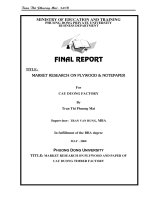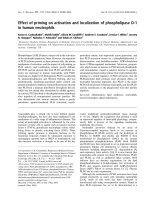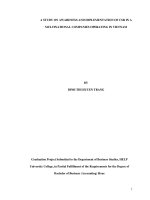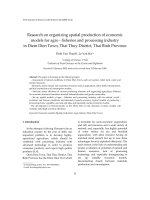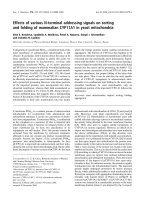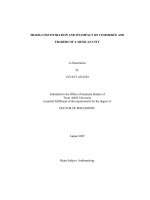market research on plywood and paper of cau duong timber factory
Bạn đang xem bản rút gọn của tài liệu. Xem và tải ngay bản đầy đủ của tài liệu tại đây (407.31 KB, 68 trang )
Tran Thi Phuong Mai - 345B
Ministry of education and training
Phuong dong private university
Business department
final report
Title:
market research on Plywood & notepaper
For
cau duong factory
By
Tran Thi Phuong Mai
Supervisor: Tran Van Hung, MBA
In fulfillment of the BBA degree
May - 2000
Phuong dong university
Title: market research on plywood and paper of
cau duong timber factory
Tran Thi Phuong Mai - 345B
Author
:
Tran Thi Phuong Mai
Student number
:
345208
Faculty
:
business department
Research company
:
cau duong timber factory
Supervisor
:
Tran Van Hung, MBA
Date
:
may 2000
Tran Thi Phuong Mai - 345B
Table of content
ACKNOWLEDGEMENTS
Executive Summary...............................................................................1
Chapter I: Introduction......................................................................... 4
I.
Establishment and Development History of Cau Duong factory........4
1.
Establishment.............................................................................................4
2.
Organization Framework............................................................................5
3.
Characteristic of Base line of Business.......................................................6
4.
Asset and Equity.........................................................................................8
II.
The Important of This Theme..............................................................10
Chapter ii: literature review.....................................................12
I.
Overview.................................................................................................12
II.
Some Concepts Related to the Research..............................................12
1.
Term “Market”.........................................................................................12
1.1. Definition.................................................................................................12
1.2. Functions of market.................................................................................15
2.
Marketing concept...................................................................................16
2.1. Definition.................................................................................................16
2.2. The Role of Marketing in Practice of a Firm...........................................17
3.
Marketing Research.................................................................................18
3.1. Definition.................................................................................................18
3.2. The Duty of Marketing Research............................................................20
III. Economic Environment.........................................................................20
1.
Environment of the economy...................................................................20
2.
Industry Structure.....................................................................................22
2.1. Plywood Production.................................................................................22
2.2. Note-paper Procession.............................................................................24
Summary...........................................................................................................26
Chapter iii: research methodology........................................27
Chapter iv: results / findings.......................................................30
I.
Results.....................................................................................................30
1.
Business Activity Analysis......................................................................30
2.
Competition Situation..............................................................................32
2.1. Domestic competitors..............................................................................32
2.2. Foreign rivals..........................................................................................33
2.3. Position of Cau Duong Factory in the Market........................................35
3.
Potential Market......................................................................................37
3.1. Note-paper Production............................................................................37
3.2. Market of Plywood for Construction......................................................38
4.
Political and Legal Factors......................................................................40
5.
Demographic factors...............................................................................41
6.
SWOT Analysis......................................................................................42
II.
1.
2.
Findings..................................................................................................44
Real State of Marketing Research in Cau Duong Factory......................44
Elements Affect on Selling-price of Cau Duong Factory.......................46
i
Tran Thi Phuong Mai - 345B
Summary...........................................................................................................47
Chapter v: limitations......................................................................49
Chapter VI: conclusions and recommendations.............50
I.
Conclusions.............................................................................................50
II.
recommendations...................................................................................51
1.
Improving Awareness of the Factory’s Staff about Marketing...............51
1.1. Solution to Consolidate and Expand the Market.....................................52
1.2. Marketing Research Activity of Cau Duong Factory in short term........53
1.2.1. Establishing a Temporary Marketing Staff.............................................53
1.2.2. Entrusting all Department with Task of doing Market Research...........53
in near future
2.
Cau Duong Factory should set up a Marketing Staff...............................56
3.
Solution to Improve Product Quality and Reduce Price..........................58
3.1. Improving Quality....................................................................................58
3.2. Improving Price Policy............................................................................59
Appendix 1: questionnaire...............................................................61
Appendix 2: charts.................................................................................67
Appendix 3: bibliography..................................................................68
Acknowledgements
The writing of this thesis has been made possible because of the guidance,
encouragement, good will and practical help of a number of people and
organization.
I am particularly indebted to my supervisor, Tran Van Hung, MBA, lecturer of
the National Economic University, for his valuable guidance, criticism,
comments, corrections, and for his kindly encouragement during the
development of this study. His suggestions and recommendations were as much
appreciated as his endurance, patience and genuine interest in this thesis
I would like to express my deep gratitude to all my teachers at Phuong Dong
University, who have been helping me for the past four years.
ii
Tran Thi Phuong Mai - 345B
I am grateful to managers, officers and staff at Cau Duong Timber Factory,
where I carried out practice, for giving me time and great co-operation.
I would also like to thank the respondents, officers and staff from various
companies that I visited for their time, patience and cheerful acceptance.
Most of all, my appreciation and gratitude is due to my parents, my brother and
my friends, who encouraged me in many ways to fulfill this study.
supervisor’s evaluation
...........................................................................................................................................................................................................................
...........................................................................................................................................................................................................................
...........................................................................................................................................................................................................................
...........................................................................................................................................................................................................................
...........................................................................................................................................................................................................................
...........................................................................................................................................................................................................................
...........................................................................................................................................................................................................................
...........................................................................................................................................................................................................................
...........................................................................................................................................................................................................................
...........................................................................................................................................................................................................................
...........................................................................................................................................................................................................................
...........................................................................................................................................................................................................................
...........................................................................................................................................................................................................................
...........................................................................................................................................................................................................................
...........................................................................................................................................................................................................................
...........................................................................................................................................................................................................................
...........................................................................................................................................................................................................................
...........................................................................................................................................................................................................................
...........................................................................................................................................................................................................................
...........................................................................................................................................................................................................................
...........................................................................................................................................................................................................................
iii
Tran Thi Phuong Mai - 345B
...........................................................................................................................................................................................................................
...........................................................................................................................................................................................................................
...........................................................................................................................................................................................................................
...........................................................................................................................................................................................................................
...........................................................................................................................................................................................................................
...........................................................................................................................................................................................................................
...........................................................................................................................................................................................................................
...........................................................................................................................................................................................................................
recommentator’s evaluation
...........................................................................................................................................................................................................................
...........................................................................................................................................................................................................................
...........................................................................................................................................................................................................................
...........................................................................................................................................................................................................................
...........................................................................................................................................................................................................................
...........................................................................................................................................................................................................................
...........................................................................................................................................................................................................................
...........................................................................................................................................................................................................................
...........................................................................................................................................................................................................................
...........................................................................................................................................................................................................................
...........................................................................................................................................................................................................................
...........................................................................................................................................................................................................................
...........................................................................................................................................................................................................................
...........................................................................................................................................................................................................................
...........................................................................................................................................................................................................................
...........................................................................................................................................................................................................................
...........................................................................................................................................................................................................................
...........................................................................................................................................................................................................................
...........................................................................................................................................................................................................................
...........................................................................................................................................................................................................................
...........................................................................................................................................................................................................................
...........................................................................................................................................................................................................................
...........................................................................................................................................................................................................................
...........................................................................................................................................................................................................................
...........................................................................................................................................................................................................................
...........................................................................................................................................................................................................................
iv
Tran Thi Phuong Mai - 345B
...........................................................................................................................................................................................................................
...........................................................................................................................................................................................................................
...........................................................................................................................................................................................................................
...........................................................................................................................................................................................................................
...........................................................................................................................................................................................................................
Evaluation of probation office
...........................................................................................................................................................................................................................
...........................................................................................................................................................................................................................
...........................................................................................................................................................................................................................
...........................................................................................................................................................................................................................
...........................................................................................................................................................................................................................
...........................................................................................................................................................................................................................
...........................................................................................................................................................................................................................
...........................................................................................................................................................................................................................
...........................................................................................................................................................................................................................
...........................................................................................................................................................................................................................
...........................................................................................................................................................................................................................
...........................................................................................................................................................................................................................
...........................................................................................................................................................................................................................
...........................................................................................................................................................................................................................
...........................................................................................................................................................................................................................
...........................................................................................................................................................................................................................
...........................................................................................................................................................................................................................
...........................................................................................................................................................................................................................
...........................................................................................................................................................................................................................
...........................................................................................................................................................................................................................
...........................................................................................................................................................................................................................
...........................................................................................................................................................................................................................
...........................................................................................................................................................................................................................
...........................................................................................................................................................................................................................
...........................................................................................................................................................................................................................
...........................................................................................................................................................................................................................
...........................................................................................................................................................................................................................
...........................................................................................................................................................................................................................
...........................................................................................................................................................................................................................
v
Tran Thi Phuong Mai - 345B
Executive Summary
In Vietnam today, the Government is implementing multi - factor economy,
including joint - ventures, foreign firms, State-owned enterprises...In which,
State-owned enterprises are considered as leading element of the development.
Thus, the most important thing for them is economic efficient, competitive
ability and position in the market.
Cau Duong Timber Factory was built in 1956 with the support of former
Socialist Republic of Czechoslovak. It was one of the earliest State-owned
enterprises in Vietnam industry; aims to rebuilt the country after a long-lasting
war. It has the task of synthetic timber procession with some main products such
as note - papers, furnitures and plywood.
Since November 1997, It has became a member of Bai Bang Paper CompanyVietnamese Paper Corporation. At present, major market of Cau Duong Factory
in North area and Ho Chi Minh City. In such narrowed market, it is necessary for
this factory to implement market research in order to expand its market in the
future.
This report is the result of a market studying by a student from Phuong Dong
University with the purpose of gene Cau Duong timber factory up on the
customers, the market and competitive real state of affairs.
Some main objectives:
Providing general market assessment including economic real situation,
industry review and the competitive environment.
Researching on business environment and an outlook of the actual market in
order to analyze decisive factor of the factory’s development.
Identifying business opportunities as well as developmental competence,
menace in the future.
Examining the influence of the outside environment: political, legislation,
culture, consuming habit, etc.
1
Tran Thi Phuong Mai - 345B
To achieve the above objectives, the project included both secondary and
primary research. The primary data were conducted from questionnaires and
directed interview in Hanoi. These were focusing on such issues as present
market, competitors, and customers, etc. Secondary data were collected base on
various information sources, magazines and other references.
The major findings are:
In some recent years, business environment of Cau Duong factory has been
enlarged resulting from the urbanization speed with a strong demand for wooden
products, especially for plywood.
Since 1996, as the urbanization rate of Hanoi has been speeded up with the
increase of 26%, many construction projects have been being taken place by
foreign constructors or domestic construction companies. This demand has been
intensified by the significant foreign directed investment capital (FDI), overseas
development assistance (ODA) and money transmission from over seas
Vietnamese. The main reason for the rise in urbanization velocity came from
out-of-date and bad condition of Vietnam’s infrastructure.
Open-door policy has been making business opportunities for foreign firms in
Vietnam. They have more competitive advantages than local enterprises in
technology, equipment, capital...Therefore, their products has more chances to
secure large part of the market.
For example, 1996, In plywood market only, imported products accounted for
42% because they meet the demand of foreign constructors in big contracts of
building; Vietnamese firms seems to be short of initiative in their own market.
Asian countries included Malaysia, Indonesia... were the main suppliers in
Vietnam plywood market with the total supplying index of 35000 tons in 1999.
However, being affected by Asia financial and monetary crisis in July 1997,
volume of imported product from these countries was reduced to 20%.
2
Tran Thi Phuong Mai - 345B
In the field of paper production, Vietnam is a large market with the total annual
demand of 75 million tons. Meanwhile, the total production capacity of the Cau
Duong factory and its parent company (Bai Bang Paper Company) only meets
the social demand of 35%. Private sector and other State-owned firms satisfied
the rest demand of the Vietnam market.
Key recommendations to Cau Duong factory will be:
Paying more attention in marketing programs, advertisement.
Attach special important to reform machinery, equipment and labor in
marketing research.
Keeping good relationships with perennial customers and suppliers.
Attending trade fairs and exhibitions to seek for new partners
Chapter I
Introduction
In order to better understand about Cau Duong factory, this chapter describes its
some sketchy characteristics and a little information about the whole economic
surroundings.
I - Establishment and development history of Cau Duong
factory
1. Establishment
Cau Duong Timber Factory is a State - owned firm, which was put in action in
July11th, 1959 and cut the inauguration band by Le Thanh Nghi, Industry
Minister, belong directly to Industry bureau – Ministry of Industry. It has the
primary mission of processing wood, manufacturing wooden product in order to
serve inland consuming and manufacturing plywood.
Becoming a member of Bai Bang Paper Company, Cau Duong factory has
processing notepaper for its parent company since November 1997.
3
Tran Thi Phuong Mai - 345B
Cau Duong factory was invested and directly managed by the State. Cau Duong
factory has juridical personality, self-contained in keeping business account and
bank account.
According to figures in 1999:
Capital for running business: VND 12,453,672,000
Total output
: VND 14,883,510,671
Labor force
: 300
The average age
: 38
Monthly income per person: VND 600,000
4
Tran Thi Phuong Mai - 345B
2. Organization framework.
Cau Duong factory was arranged in model of one leader.
Director
Production-Vice Director
Material
shed
KCS
Department
Paperprefabrication
Plant
Investment-Vice Director
Economic-Vice Director
Personnel,
Woodprocession
Workshop
Administration
Bureau
and
Wage control
Capital
construction
Health-care,
Security,
Pre-school
5
Sales
department
Finance
bureau
Repository of
end-product
Tran Thi Phuong Mai - 345B
3. Characteristic of basic line of business
Cau Duong factory’s line of business is abundant with many kinds: woodwork,
pencil, plywood, sawn timber, broom-stick, B 40 gun nest, loom’s spare part,
racket, boat, etc. However, principal commodities are plywood and notepaper
owing to basic earning resource.
Plywood
+ Total output of 1000 m3 annually
+ Plywood is manufactured in continued, self-contained process.
+ Material: Rough-timber,
Technical proportion: 1000 m3 of plywood need 2500 m3 of rough-timber.
Material suppliers: State-owned and legal private afforestation yards in the
mountainous of north area.
Note-paper
+ Designed capacity: 3000 tons per year
+ Material: Paper pulp (Provided by Bai Bang company)
+ Processed in these closing-stages of work
Paper-germ
Line-drawing
Binding
Trimming
Packaging
Technological process.
So far, Cau Duong factory has utilizing production line of former Socialist
End-product
Republic of Czechoslovak. Backward technology with 70% of 1960s and 1970smade machinery, is the main reason for high production expenses and limited
quality. The consequence of cumbersome and less effective machinery than
6
Tran Thi Phuong Mai - 345B
modern one, high depreciation expenses and obsolescence closely related to high
selling price of Cau Duong factory.
7
Tran Thi Phuong Mai - 345B
4 - Asset and Equity
Asset
Table 1B - Balance Sheet
1997
Criteria
Amount
1.Current assets
1998
1999
98 / 97
99 / 98
Unit of measure
(%)
Amount
(%)
Amount
(%)
Amount
(%)
VND 1000
1615733
15.23
2177265
18.53
2711567
21.77
561532
Monetary assets
VND 1000
451360
4.25
663972
5.65
680564
5.46
212432 147.06
Inventory
VND 1000
193020
7.48
1022716
8.71
1494852
12
Account receivable
VND 1000
187325
1.77
228282
1.94
297514
Other current assets
VND 1000
184028
1.73
262475
2.23
VND 1000
8992136
84.77
9571268
VND 1000
10607869
100
11748533
2. Fixed assets
Total
(%)
534302 124.54
16592
102.5
128.9
472136 146.16
2.39
40957 121.86
69232 130.33
238637
1.92
78447 142.63
81.47
9742105
78.23
579132 106.44
100
12453672
100
1140664 110.75
8
229696
134.8
Amount
-23838
90.92
170837 101.78
705139
106
Tran Thi Phuong Mai - 345B
Due to the characteristic of business field, fixed asset takes a large part in total
equity, about 80%, liquid asset for doing business is restricted. Hence, capital
privation has restrained Cau Duong factory from expanding line of business,
improving quality, reducing price and strengthening competition ability.
The chart above has presented the upward trend of liquid assets density and the
decrease in fixed asset from 1997 to 1999. It means, capital for running business
has been strengthening. However, compare to 1998, financial difficulties in 1999
came from large amount of stocks of VND 1494852000 (increase 46.16%) and
appropriated capital by its consumers of VND 297514000 (30.33% higher than
1998), meanwhile, cash capital was slightly increased (2.5%). In order to escape
from capital scanty, the factory must take back the appropriated capital and
establish a sensible policy of inventory.
Capital.
Table 1 A - Capital statement
Criteria
Unit of
measures
1997
1998
1999
98 / 97
(%)
99 / 98
(%)
1. Capital classification
VND 1000
10607869
11748533
12453672
110.8
106
Fixed capital
VND 1000
7481546
8032578
8822396
107.37
109.83
Liquid asset
VND 1000
3126323
3631276
3631276
118.86
97.73
2. By ownership
VND 1000
10607869
11748533
12453672
110.8
106
State capital
VND 1000
9308404
10436070
11112395
112.11
106.48
Owners equity
VND 1000
1299465
1312463
1341277
101
102.2
Paid-in capital
VND 1000
0
0
0
0
0
Equities
VND 1000
0
0
0
0
0
Table 1A and 1B reflects real situation of Cau Duong factory’s capital. As can be
seen, budget capital and owner’s equity has manifested ability of financial
independence. However this situation has led to difficulties in mobilizing all
capital resources for developing and expanding business activity, meanwhile, the
factory’s difficult solving competence depends on limited bank loans and credit
organizations.
II. The importance of this theme
According to the figures given by Planning and Investment Ministry, Vietnam
has allowed 270 foreign investment projects, which are acting in building and
9
Tran Thi Phuong Mai - 345B
construction material domain, with the total registered capital of USD 3,5 billion.
So far, these projects have reached USD 1.1 billion of the total working capital.
A top construction expert said that foreign investment projects had brought
Vietnam many modern facilities, and new management experiences. However,
the high level of competition in domestic construction material market must be
also dealt-with. If local manufacturers did not have any specific strategy, they
would be knocked-out in their own market.
In addition, paper production branch is facing unforeseeable losses, resulting
from the target of satisfying the interior market demand. In the context of a spike
in paper-pulp and having no declining sign, many paper companies have decided
to reduce imported paper-pulp from 40% to 10%.
In this circumstance, Vietnamese enterprises need to answer following
questions:
How to cope-with the market displacement in the most effective and fastest
way?
In a high-level of competition, what will they do to enhance their competition
ability?
Customers are the vital element of a firm, how to meet their requirements in a
profitable and more effective than competitors?
In order to survive and develop in such high competitive environment.
Enterprises need to find the right way of development; the most effective
instrument for their target determination is market research. Besides, in the
unstable and ceaseless changed market, market research should be taken place
regularly. Market research is always the first step of patrons’ demand defining,
plans building, leaders’ decision making… and it becomes the key step of a and it becomes the key step of a
firm’s development.
As mentioned above, Cau Duong factory has been running business in a
narrowed, high competitive intensity market, therefore, market research duty
becomes an insufficient, more and more pressing activity.
Although several market studies were carried-out, Cau Duong factory still need
an up-to-date and comprehensive market analyzes of present business medium
10
Tran Thi Phuong Mai - 345B
for its future development. This project aims to provide the firm’s practical
background, general market assessment, including economic situation,
competitive environment, and reliable information about the customers,
predilection... so that they can run business in an effective way.
The researcher hopes that this study would provide a little but helpful-information
source, which can be used in practical activities of Cau Duong factory.
Scope of the project.
Owing to time limited, this research only bounded some products: Notepaper
and water - resistance plywood for using in construction industry.
11
Tran Thi Phuong Mai - 345B
Chapter ii
Literature review
This chapter introduces readers a list of related documents and theory that the
researcher utilized as reference documents for the project, and also deals with
impaction of objective elements to Cau Duong factory’s present position in the
market.
I. Overview:
This research is accomplished base on studying and consulting many documents
gathered from various sources. In order to reach objectives of this study, the
researcher had to gather information on the past researches in library, some
offices and interview officers. Researches and analyses found includes the
following:
CD - ROM database of Vietnam News Agency
Articles in other newspapers and journals such as Vietnam Economic News,
Vietnam Economic Times, Vietnam Investment Review, Business and
Marketing News.
Some reports that are available and concerned with the research.
II - Some concepts related to the research:
1. Definition of term “market”.
1.1. Definition.
The category of “Market” had appeared long - long ago. In primitive age, it
existed in form of batter economy, in which, goods are directly traded or
swapped for other goods. This was the most incipient style of market. Later,
money appearance simultaneously with market development; the definition of
“buyers” and “seller” was taken shape all there factors has created a full
definition of “market”.
Today, in developed society, market notion is wider and more abstract
understood, it is not only a physical location, where buyers and seller interact,
but also every where: on the train, at the street, etc. In addition, consumers and
sellers can use means of intermediary such as: communications and liaison
12
Tran Thi Phuong Mai - 345B
resource, brokers instead of direct meetings. The market expansion is a
foundation to enhance the development of society.
There are many definitions about market. Below are some of them:
- By Traditional view: Market is place where buying, selling and exchanging
activities are carried-out (Enterprise, number 4,1996, p.6).
- By Marxism: Market is a circulation stage in reproduction process.
- By Capitalist Political Economics: Market is a process, in which buyers and
sellers interact each other in order to determine quantity and price of goods
(Enterprise, number 4,1996, p.6)
How ever, the more developmental the social is, the more different the market
definition be understood. According to the trend today, enterprises’ activities
need to be market-oriented, in concrete, satisfy the customers’ demand.
Contemporary point of view puts the customer in the central position because in
modern life, a firm’s existence greatly depends on the number of customers it
has. In marketing sentiment, definition of the market only concentrates on
buyers market: “An enterprise sells what the customers need, do not sells what
they produce”.
P. Kotler and G. Amstrongs (1994) explained the notion of market as follow: “A
market is the set of actual and potential buyers of some products”.
Also, this definition has placed some questions that firms need to answer:
How do the customers choose among these many products?
Why do they choose this product rather than that one?
There are some kinds of market that marketing-standpoint suggested (JP Lacour
- Lexique du Marketing, Editions “Bertrand - Lacoster”, Paris 1993,6)
13

